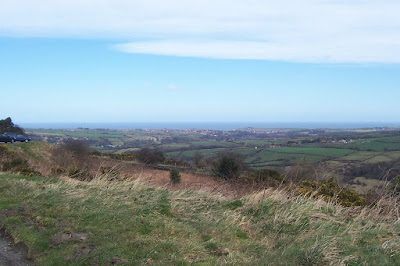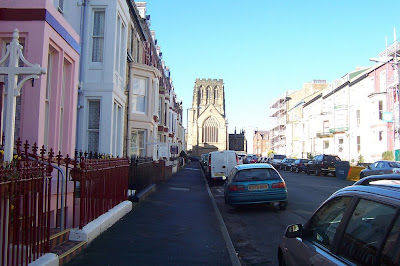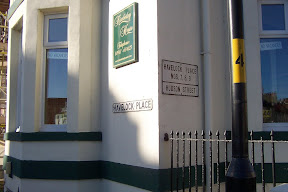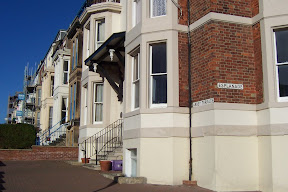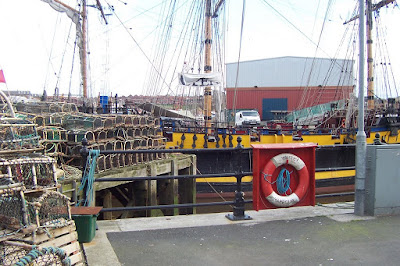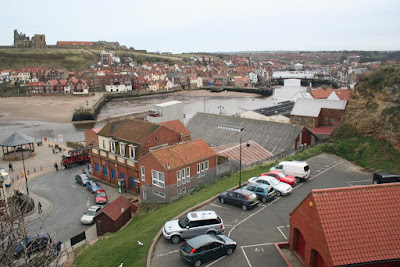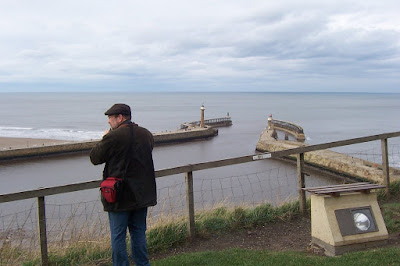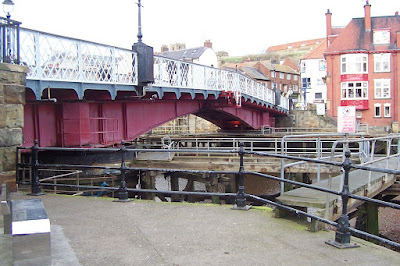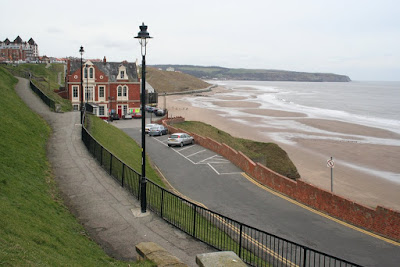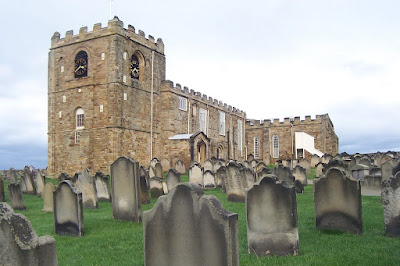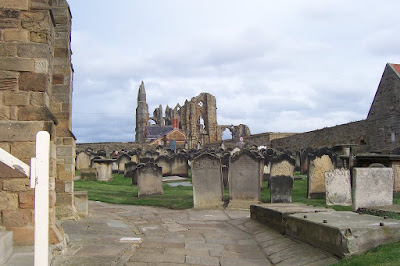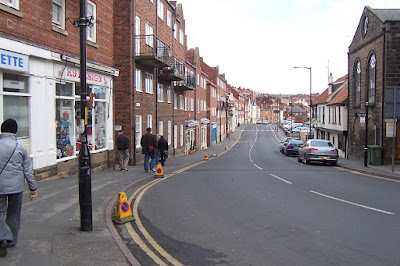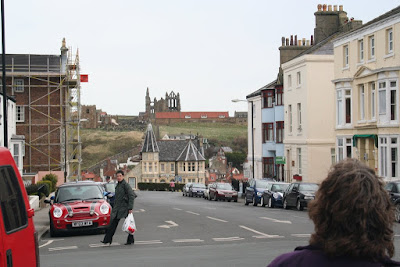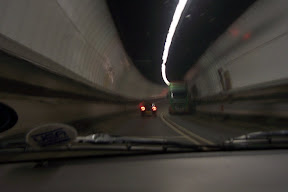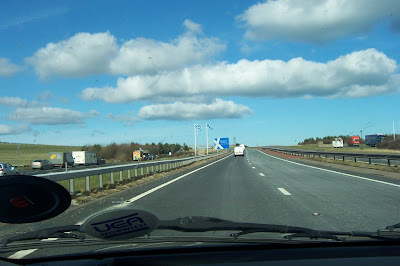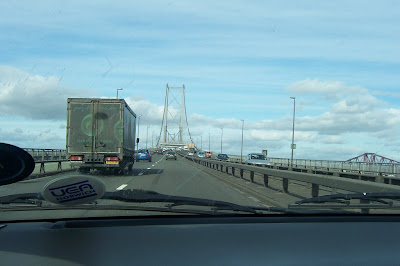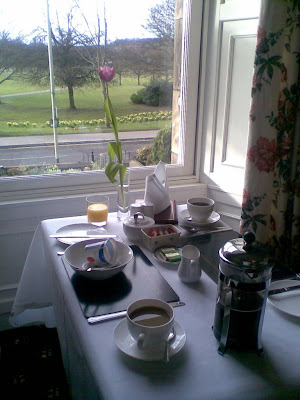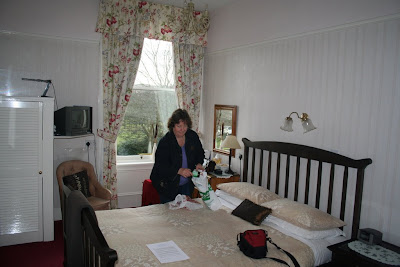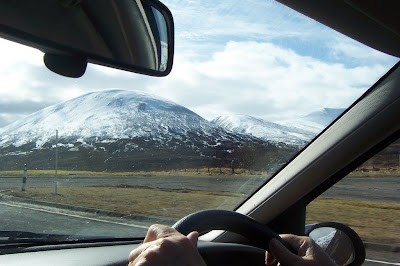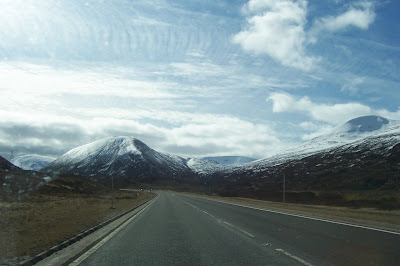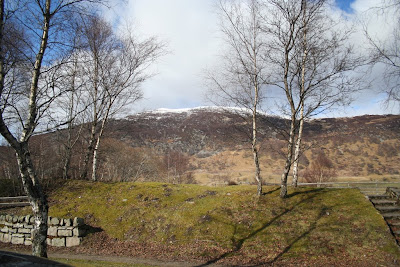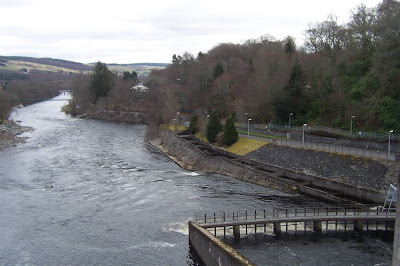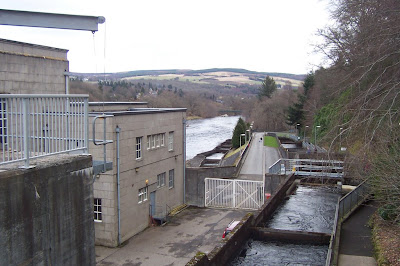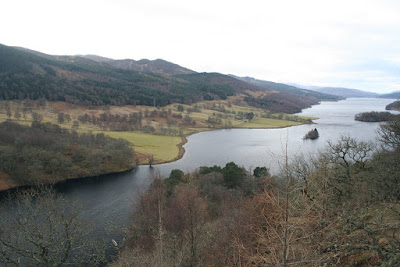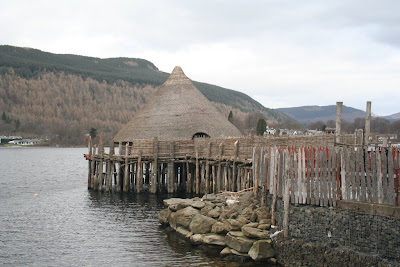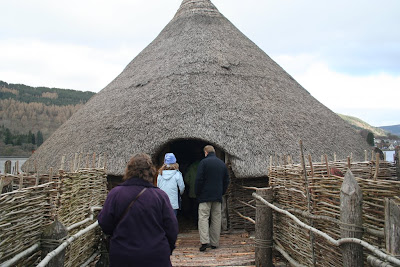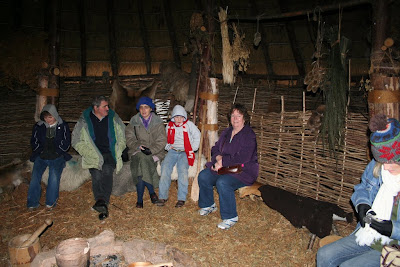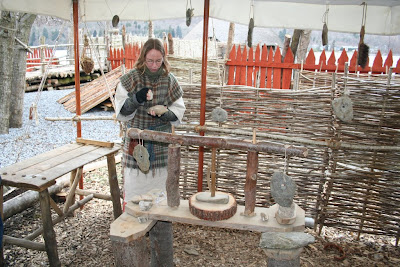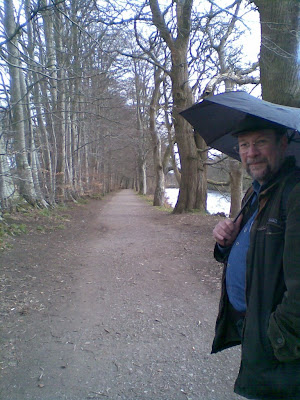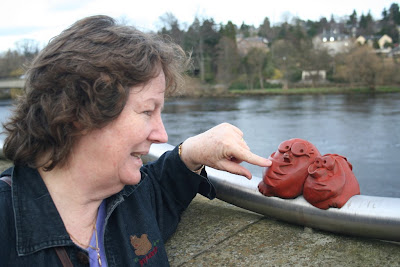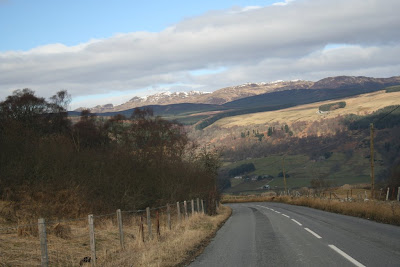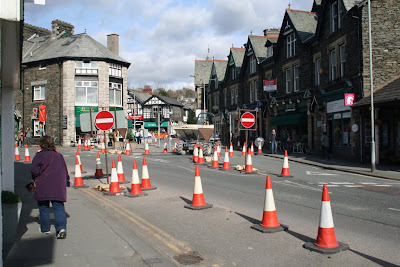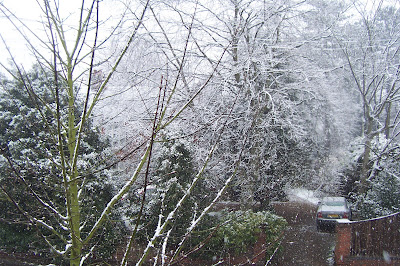At "INTO University of East Anglia" the staff do not get holidays just because the students do. On days like Good Friday, of course, the place is all locked up, but for the rest of the Spring Break, while the students are off, the staff are still expected to show up and ... well, work. Find something to do - marking, preparation, whatever. Of course "INTO" doesn't actually provide desks, and certainly not computers, for each staff member, so when there are no classes we are all thrown together in the inadequate office where the kettle sits on the floor because we can't spare the desk-top space for it.
However, we do get holidays. We have to apply for them, and if we don't use up our allowance in the year they evaporate. With the two of us wanting our holidays at the same time, and being considerate sorts - not wanting to cause too much disruption as they seem to be unable to find 'cover' teachers when someone is away sick (or on holiday) - we opted to take holidays at least mostly while the students are on break. And we figured it would be better to do our driving and return home before the Easter Madness on the roads started.
It seemed like a good plan. Unfortunately we didn't really believe to what extent the whole of the UK tourism business closes down over winter, and refuses to open until April, regardless of the weather. Even when Easter is early. Every castle, museum, even gardens, and (of course) public toilets ... all locked and barred.
For the week before our break, gale force winds caused havoc across the UK, but that all passed before we set off. The weather was fine and mostly sunny. Spring has definitely arrived in England.
Heartbeat country
I have always enjoyed the TV program "Heartbeat", which has been on TV in the UK and Australia for years and years. It's hard to say why it's so appealing - the music, the characters, the scenery - but it always had a familiar homely feel to me. (Whereas Coronation Street does nothing for me!)
Heartbeat is set in a small (imaginary) village called Aidensfield on the Yorkshire moors near Whitby. Actually the real place, where they do the filming and stuff, is called Goathland.
More importantly than that, my mother was born in Whitby. So we decided to visit there first.
This was our first sight of Whitby, from 'Blue Bank' car park, a windy spot up on the moors not too far from Goathland.
Streets with two names
We had booked a B&B in Hudson street - a nice wide street, with parking on both sides (unusual in the UK!). A friend pointed out to us that although this was in fact Hudson Street
(there's the name)
the other side of the street is called Abbey Terrace.
When the streets were being built, some Irish men were responsible for building them and were paid according to the number of completed streets ... clever little Irishmen, ay?
Whitby - a village with two sides
Whitby is a fishing village.
The fishing can't be too bad, because we found we were eating fish from Whitby when we were in Scotland.
The River Esk divides the village in two.
On that side, on the hilltop stark against the sky, are the ruins a of the old Priory, and St Anne's church.
There's the river mouth
and the "Swing Bridge" that swings open like a door to let the boats up the river.
On this side of the river there are sandy beaches going all the way up to the village of Sandsend.
Although Whitby is on the East coast of England, it actually faces north. We went across to the East side of the river to have a look at St Anne's church.
It's (apparently) one of those churches with box pews, and wealthy people would pay to have the best seats ... but anyway we were too late in the day and couldn't go in. The churchyard was full of these incredibly old-looking graves. But a lot of them are not that old, just incredibly weathered on this wind-swept promontory.
The abbey ruins were also closed to tourists. But without getting close we could see that it was a magnificent building in its time - inhabited now by pigeons grateful for the shelter.
We were feeling the effects of the cold wind, and of course the public toilet was also closed.
So we scrambled down the 99 steps to the East side of Whitby town. This street has fairly modern buildings - apparently this is where my Great-Grandfather's cobbler shop used to be. Most of the other streets on this side are narrow, cobbled, some of them mere snickets (small lanes) and a great little touristy precinct now. I guess Great-Grandpa's shop got cleared away to make a road wide enough for cars.
Back on the West side, looking down Hudson Street / Abbey Terrace you can see the Abbey ruins high on the other side of the estuary.
On up to Scootland
We've been practising saying it right - "Scootland" and "snoow".
After years in the real Perth, in Western Australia, we decided to spend a few days in the fake Perth in central Scotland.
We paid a couple of quid to go under the river Tyne.
And then scooted across the border into Scotland.
Yep, that's the border. No fanfare.
We skirted around the bottom of Edinburgh - just another city, not what we had come to see - and then we had to pay another toll to get across the Firth of Forth (at the narrow bit).
The Fake Perth
Nice little city, on the River Tay.
We went for a little walk, and found some cute little sculptures by the river. I particularly liked this one
of a duck diving through the water, all done in metal.
We stayed in a splendid little B&B called Kinnaird House.
It was right on the south part of the city ring road, overlooking a park called the South Inch. (There is another park at the other end of town called the "North Inch".)
We had a lovely room, and most of the time we were the only guests - seeing as it wasn't April or Easter yet and Scotland was still closed. If you are looking for a B&B in Perth, I recommend this place. All the nice little touches made it very special. Like a little tartan covered cardboard box on the bedside table containing two welcome choccies - replaced every day we were there. Everything was bright and clean and fresh and well thought out. There was no parking out the front, but they have a large garage in a back lane way where they make space for about four cars.
The Scootish 'Ighlands
From Perth it was easy to drive up into the Scottish Highlands, and it was certainly beautiful - as least that wasn't closed.
The weather was fine and beautiful, although there was snow on the mountains.
I was a bit surprised by how brown and dead everything looked. We had just left England in the full bloom of spring - daffodils and crocuses brightening the road verges and trees just bursting into blossom. Here the white of the snow contrasted with the varying browns of dead heather and dead bracken, varying to the dark green of evergreen forests and the slight purple haze of deciduous twigs.
Great picnic spots - as long as we stayed in the car - beautiful scenery.
The Fish Ladder at Pitlochry
This was one thing we had been keen to see - and fish don't pay any attention to calendars, do they?
Pitlochry has one of many hydro-electric stations in Scotland. The problem is that when the salmon swim upstream to spawn Wham! they run into this whacking great dam.
That down there is where the fish come from, and I'm standing up here on the dam. Over there to the right you can see the beginning of the fish ladder - a series of (34, I think) pools for the fish to work their way up.
Now here you can see more of the ladder. They come up on the left, round the bend, and continue on up. Where that bigger pool is, there's an observation room where you can go in and watch them go by. Only, right now ... it's still closed for the winter.
We were wondering how the fish make it up that ladder, how they know to jump over those cement dividers. The water in the pools is all swirly and dangerous-looking - there are signs everywhere about danger of drowning so don't fall in! Then we realised there is a pipe at the bottom joining the pools to one another and the water is rushing through and the fish swim up against it. 3 or 4 of the pools are "rest pools" with less swirling, but we couldn't tell which ones.
And there weren't any fish anyway - because they don't start running till April. They DO know about the calendar! And they keep running all the way till September or something.
The View - the Queen's View
So then we went to see the view from "Queen's View".
Well, obviously we had to go and see this one. It was named for Queen Victoria - who found that a little surprising when she finally went to see it, long after it was so named.
So, yeah, it was pretty speccy, and we even stopped and had soup and home-made cake in the visitors centre.
Do you know what a Crannog is?
I discovered one place that was open - the "Scottish Crannog Centre". So we had to go and see that.
Apparently someone found an interesting pile of logs and mud at the bottom of this lake, and reconstructed life on the lake some 2 500 years ago. The mud had preserved everything so perfectly they were able to make all sorts of presumptions about like back then!
And there it is, a reconstructed Scottish Crannog.
We tread carefully across the slippery logs and into the bracken-lined crannog.
For some reason they hadn't lit the fire - they reckon they do usually. We sat on animal skins on wooden benches as the wind gradually picked up outside and blew through the woven walls. It was interesting, if a little fanciful, and the inevitable American tourist in the group had to have her say over everything that she didn't know - including not having ever heard of bracken fern before.
We were very glad to come back outside and move around a bit. Then young Marike showed us a few things about how to survive in the stone age - necessary skills like how to make a hole in a stone. She tried to show us how to make fire, but all she got was a little smoke and a few sparks. And there were some machines set up so we could have a go with a primitive lathe.
The weather had turned, a few flakes of snow fell and we were glad to climb back into our warm car and leave the beautiful lake and the crannog.
With everything else still closed there wasn't much else to do except take a few walks.
This gentle ramble is called "Lady Mary's Walk".
Time to say G'bye to Perth and head back to England.
The Lake District
Spectacular mountains and lakes in England's north-west. But, not surprisingly, it was not that special after the Scottish highlands.
Windermere town was swarming with tourists, although the town was not really ready for them.
The village was still in the throes of major roadworks to get ready for the throngs in summer.
Home again home again ...
We woke up to wind and rain - the fine weather was gone. The British motorways are amazing - we were able to go almost all the way home on the M6. The traffic was quite heavy, lots of lorries (that's what they call trucks here) , three lanes of traffic through the rain and spray ... and yet no hold-ups at all.
Home to a White Easter. Where did Spring go, and all the bunnies and stuff??
Sunday, March 23, 2008
Sunday, March 2, 2008
Daily Routines
We are slowly getting the hang of how things are done in Britain, and specifically Norwich. It's amazing the little everyday things that you take for granted.
Some things are to do with living in a different climate.
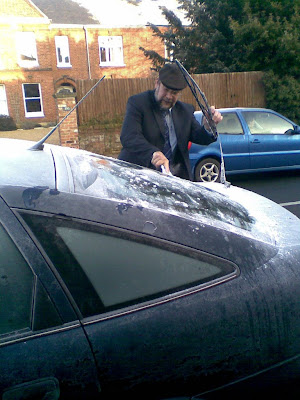
Even on a fine-looking clear morning there may still be thick ice to scrape off the car before you go anywhere.
Then there is our job at the University of East Anglia.

With jobs we have held elsewhere we have been free to do anything - even go home or go shopping - at times when we weren't teaching. In this job we have to stay "at the office" between classes. Nevertheless this room is office for more than 30 teachers, but there are only 15 desks and 5 computers. They call it hotdesking, but we call it not putting true value on your teachers.
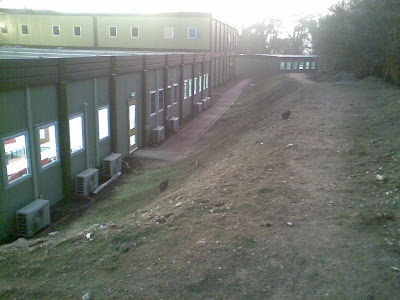
This is outside the teachers' room - no great views here - do you notice the bunnies?
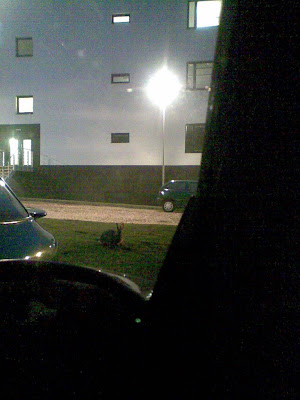
We still find it funny to have them hopping about everywhere at the University.
The Secret Garden
At least we have weekends off. Last weekend we opened up a Norwich Visitor Map, to find somewhere to go and see. A place called "Plantation Garden" was recommended.
"A wonderfully restored idiosyncratic Victorian town garden including a gothic fountain, a rustic bridge, an Italianate terrace, an amazing "medieval" wall and hundreds of architectural details fashionable in the mid 19th century."
Well that might be worth seeing.
It was a little hard to find, hidden between the Catholic Cathedral and the Beeches Hotel.
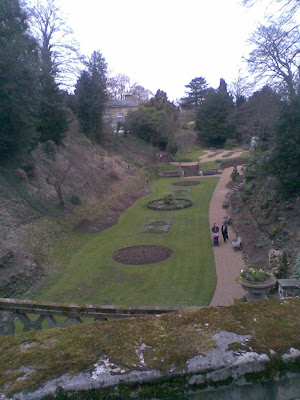
It seemed to be in a bit of a hole. We had been wondering recently where all the flint-stones came from for the magnificent old buildings around town - well this is one place. Flint and lime were mined here, and then the whole thing kinda fell in I gather.
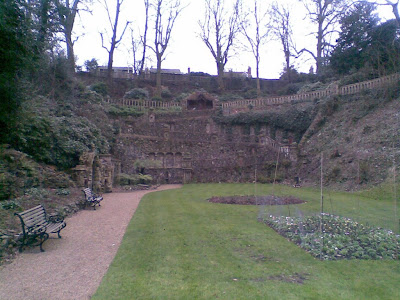
All these amazing walls and stuff were made from oddments from a brick factory.

It's a bit like when someone at a beach resort decides to cover their house with collected shells - interesting for the first few hours and then it's all just a bit much.
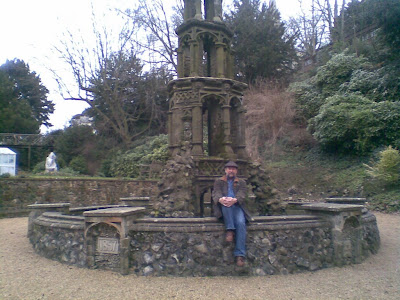
We found the gothic fountain, with a massive goldfish swimming around.
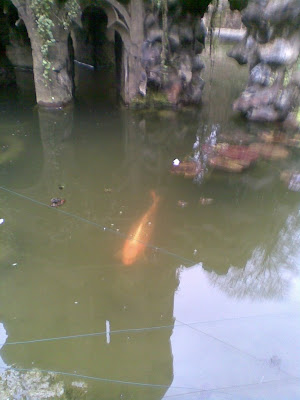
We had fond memories of PlaySchool and looking through the arched window.
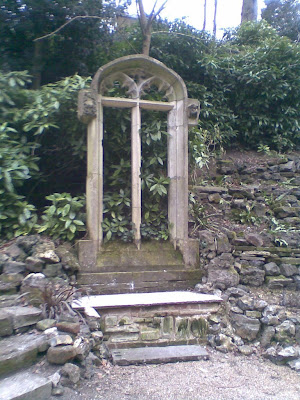
There were so many of these bits scattered around.
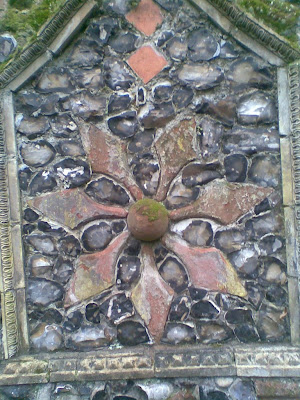
If this had been China there would have been no moss growing on that knob, everyone would have been convinced it was lucky to rub it.
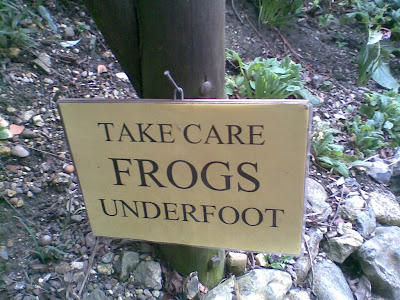
This sign near the garden entrance was a bit of a puzzle.
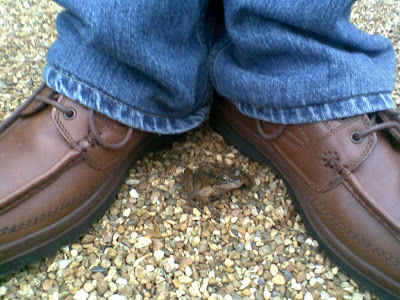
We saw one little frog - actually, I think it's a toad! - hopping around the gravel by the fountain. Actually, there were at least two, so maybe in Spring there'll be lots.
What can I say. At two pound a pop ... well there was an honour box ... maybe you can save your money now that you've seen this.
Some things are to do with living in a different climate.

Even on a fine-looking clear morning there may still be thick ice to scrape off the car before you go anywhere.
Then there is our job at the University of East Anglia.

With jobs we have held elsewhere we have been free to do anything - even go home or go shopping - at times when we weren't teaching. In this job we have to stay "at the office" between classes. Nevertheless this room is office for more than 30 teachers, but there are only 15 desks and 5 computers. They call it hotdesking, but we call it not putting true value on your teachers.

This is outside the teachers' room - no great views here - do you notice the bunnies?

We still find it funny to have them hopping about everywhere at the University.
The Secret Garden
At least we have weekends off. Last weekend we opened up a Norwich Visitor Map, to find somewhere to go and see. A place called "Plantation Garden" was recommended.
"A wonderfully restored idiosyncratic Victorian town garden including a gothic fountain, a rustic bridge, an Italianate terrace, an amazing "medieval" wall and hundreds of architectural details fashionable in the mid 19th century."
Well that might be worth seeing.
It was a little hard to find, hidden between the Catholic Cathedral and the Beeches Hotel.

It seemed to be in a bit of a hole. We had been wondering recently where all the flint-stones came from for the magnificent old buildings around town - well this is one place. Flint and lime were mined here, and then the whole thing kinda fell in I gather.

All these amazing walls and stuff were made from oddments from a brick factory.

It's a bit like when someone at a beach resort decides to cover their house with collected shells - interesting for the first few hours and then it's all just a bit much.

We found the gothic fountain, with a massive goldfish swimming around.

We had fond memories of PlaySchool and looking through the arched window.

There were so many of these bits scattered around.

If this had been China there would have been no moss growing on that knob, everyone would have been convinced it was lucky to rub it.

This sign near the garden entrance was a bit of a puzzle.

We saw one little frog - actually, I think it's a toad! - hopping around the gravel by the fountain. Actually, there were at least two, so maybe in Spring there'll be lots.
What can I say. At two pound a pop ... well there was an honour box ... maybe you can save your money now that you've seen this.
Labels:
East Anglia,
hotdesking,
icy conditions,
INTO UEA,
Norwich,
office,
plantation garden,
rabbits,
routines,
teaching ESL,
UK
Subscribe to:
Posts (Atom)
